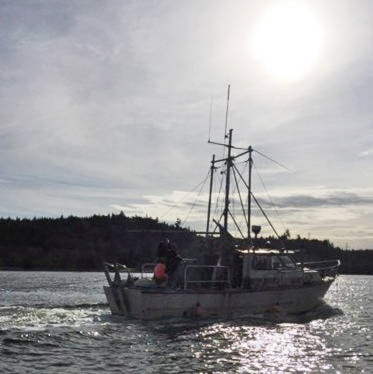Talks are ongoing but so far there is no agreement one month into the logging protest at Collison Point / St’alaa Kun.
People familiar with the talks said some of the short-term options on the table may include allowing Husby Forest Products to collect harvested logs now lying in the water or on land before they are vulnerable to infestation. In response to the protest, Husby recently applied for a court injunction, serving notice to the protestors on April 12.
B.C.’s forests ministry has said that senior officials from the province and the Council of the Haida Nation are working on a letter of understanding, but cautioned that those negotiations may be limited given that the people occupying the land are not represented by the CHN.
Neither the CHN nor Husby Forest Products has yet spoken about the protest publicly.
“I just have hope,” said Port Clements Mayor Urs Thomas, speaking about the latest all-islands protocol meeting on the issue.
“The discussion in the room was good, there was no animosity. Let’s see what the outcome is going to be.”
Speaking in Old Massett last week at an update meeting for the Haida Gwaii Land Protectors, Lisa White said it’s been a challenging few weeks.
“It’s been really challenging for our protectors who were willing to go out there and stand on the line,” she said, noting that Collison Point is about an hour’s boat ride away. Organizers have so far supplied a group of between three and seven in a wall tent at the site.
“It’s quite isolated, which I think is why a lot of our people haven’t been able to get across there,” she said.
Marilyne Carmen, another member of the Haida Gwaii Land Protectors, said people in the group hold differing views on forestry, but all agree on three core ideas: Haida sovereignty, Haida law on Haida land, and time for logging to change.
“The industry, sure, it’s a bit better with the land-use objectives order, but not really,” Carmen said.
“There is still so much bad practice — yellow cedar being burned or buried — and we know we can do better.”
“As an ally, I support the Haida people to take a stand right now to protect what is theirs.”
Looking over a map showing the existing and planned cutblocks at Collison Point, White said the area has been devastated.
“There are very limited amounts of any old-growth,” she said. “I hope that we can save what’s left.”
White and others called for a third-party, independent audit of the area to inventory the forest, waterways, and plants used in traditional Haida medicine.
“We need Haidas on the ground, too, working with them, so we feel the process would be more accurate,” she said.
The Council of the Haida Nation recently finished building a cabin at Collison Point for staff to monitor forest practices, the environment, monumental cedars, and the effectiveness of the Haida Gwaii Land Use Objectives Order. In 2016, a random audit of Husby’s work at Collison Point by the B.C. Forest Practices Board found it met legal standards set by both by the land-use order and provincial laws.
In Port Clements, where the protest at Collison and recent blockades of BC Timber Sales have led to several layoffs, some concerned residents asked council to look beyond logging.
“Why is Port Clements a single-industry town?” asked Joan Hein, who submitted a list that she and others made showing dozens of ideas for diversifying the local economy in Port.
Some of the suggestions were short-term, such as hiring more public works staff, while longer-term ideas included starting a local tree nursery, an SPCA facility, affordable housing and seniors homes, as well as encouraging secondary industries like furniture and houseboat building.
“This logging fiasco has been coming for 30 years. Why previous councils haven’t done anything, who knows,” Hein said.
“But we need to find a secondary industry — there’s opportunity here, let’s get active, let’s find something”
Mayor Thomas thanked the group and praised the suggestions, but said council’s current priority is to encourage negotiations on forestry.
We are doing our best to try and lobby the people that have the power to find a happy medium for everybody so we can get our workers back here,” said Councillor Betty Stewart.
“It hurts me to see my friends leave here — there’s nobody along my lane anymore, and that’s not right.”
Councillor Charleen O’Brien Anderson agreed.
“Forestry is a renewable resource, in my opinion,” she said. “There is lots of logging to be done here on island, and it can be done in a way that’s managed properly.”
As for secondary manufacturing on island, O’Brien Anderson said it’s a great idea, but more challenging than people realize.
“It should be happening here, it should have happened many years ago,” she said.
“But it’s going to take a lot of time and a lot of money to set up.”
